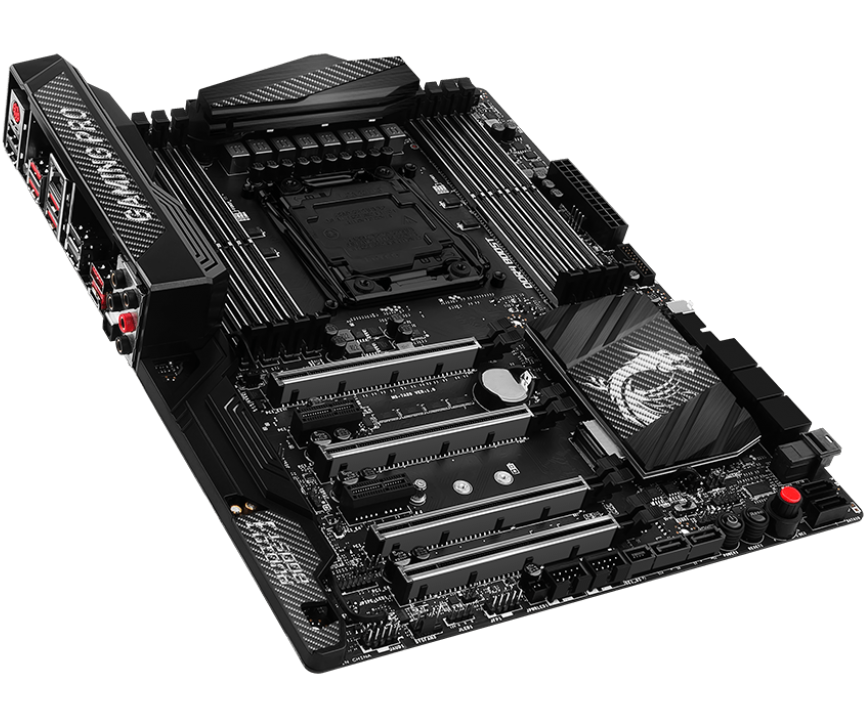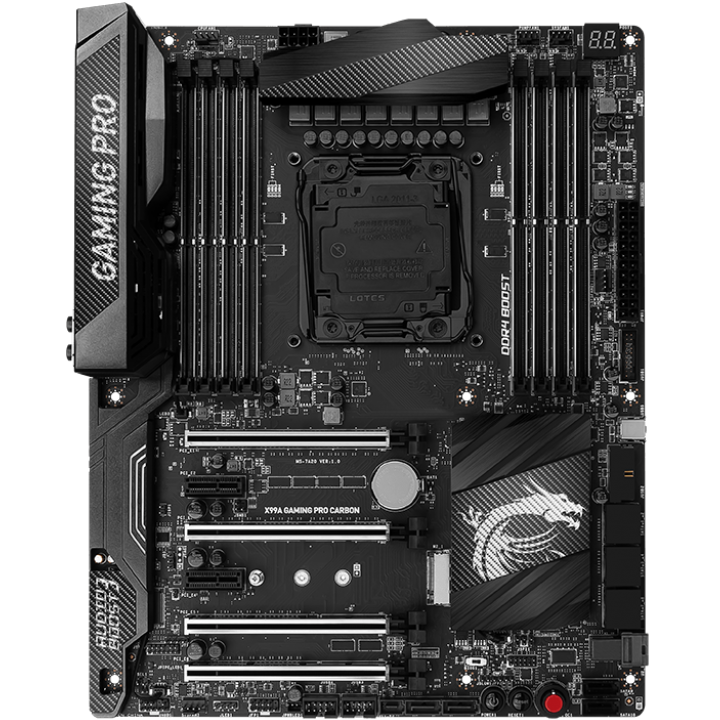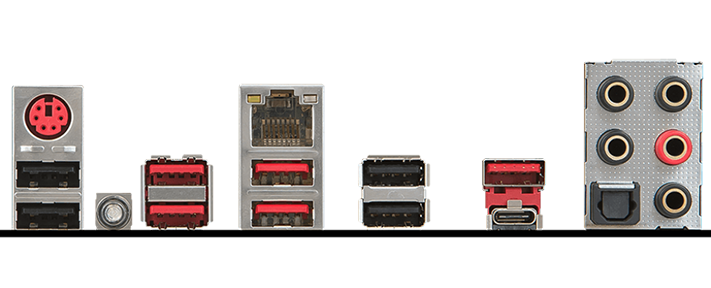Early Verdict
This is a great CPU overclocking board for the price, and it's a worthy board for all others if you can find it under $300.
Pros
- +
Proper 3-way GPU support with both 40- and 28-lane CPUs
- +
M.2 stays at 3.0 x4 with multiple GPUs
- +
strong CPU overclocking potential
- +
internal type-C port
Cons
- -
No voltage check points
- -
handicapped fan headers
- -
internal type-C port only USB 3.0.
Why you can trust Tom's Hardware
Features & Specifications
It's nothing new that higher performing components cost more than their pedestrian stablemates. However this price premium seems impact in the X99 market more heavily. Entry-level Z boards start around $100, and boards in the $150 range would satisfy all but the most serious power users. With the exception of top-tier models, X99 boards are about twice the price of their Z counterparts, with basic models around $200 and the best-equipped products starting in the $300 to $350 range.
With the X99A Gaming Pro Carbon, MSI is trying to bring a premium board in at the $320 mark. It would be a compelling option if it succeeds.
Specifications
Features
It wouldn't be inaccurate to say the Gaming Pro Carbon (GPC) is the little brother of the Godlike Gaming (and its subsequent Carbon revision). Slightly thinner (at 1.5mm) than many competing products, component differences are most prominent in the power regulation and delivery. Instead of an 8+4-pin EPS with a 12-phase super-ferrite regulator, the GPC drops to only 8-pin power input and 8-phase regulation using titanium chokes.
The voltage control and chipset heatsinks, featuring the typical carbon fiber motif of the product's namesake, are also smaller. While this might hamper extreme overclockers on LN2 or active refrigeration, those using normal air towers and liquid loops needn't worry. Remember Chris and Igor used this same board to take the Core-i7 6950X up to 4.3 GHz. This also allows the GPC to be smaller than the Godlike, resulting in a more case friendly regular ATX size.
Overall fan header layout is decent, but could be better. Three of the five headers are across the top of the board, suggesting the GPC caters more to top mounted radiators rather than rear exhaust fans. The fourth header is sandwiched between the steel-wrapped RAM slots and 24-pin power jack on the front edge, making it difficult to access after the system is assembled. The fifth header is on the bottom left corner, which makes it nice for bottom or side fans, but inconvenient for lower front intake fans. What looks like a board focused on liquid cooling comes with a large caveat.
While the GPC's second fan header is specifically labeled for pumps, it offers no PWM support. None of the headers do, except for CPU Fan 1. Many pumps today draw power directly from the PSU over a Molex or SATA connection, while a second cable connects to the motherboard for tachometer and PWM signals. Using a such a pump with the Gaming Pro Carbon means connecting it to the CPU fan header and running all your other fans off voltage control. It's an inelegant workaround for a problem that should not exist in the first place.
The GPC has four x16 and two x1 slots. Like the DIMM slots up top, MSI reinforces the x16 slots to make them stronger under the weight of GPUs. The manual lists the wiring as four-way graphics compatible with a 40-lane CPU (in an x8/x16/x8/x8 configuration), however it's only three-way SLI and CrossFire certified. Without a gap between the third and fourth PCIe x16 slots, four-way GPUs would only be possible by liquid cooling the cards. With the current shift in the graphics market, particularly with NVidia nixing most support for three and four-way SLI, we don't see this as a notable problem. Whether using a 40- or 28-lane CPU, the Gaming Pro Carbon can simultaneously run three GPUs at x8/x8/x8 bandwidth and 3.0 x4 PCIe storage.
Get Tom's Hardware's best news and in-depth reviews, straight to your inbox.
We would give one suggestion to all motherboard manufactures: widen the GPU lock release tabs. The typical whale-tail tabs don't extend past GPU backplates, making it more difficult to remove a GPU.
For storage, the GPC features X99's usual array of 10 SATA 6Gb/s ports. Six are forward-facing on the bottom half of the front edge with the other four along the bottom (two of which function as a SATA Express connector). For PCIe storage, you get a U.2 jack at the bottom front corner and an M.2 slot in the fourth PCIe slot, wisely away from GPU heat. The M.2 supports modules up to 80mm and both are 3.0 x4 and NVMe capable but also share PCIe lanes with the bottom x16 slot. The U.2 is completely disabled if a PCIe card is used in the slot. The M.2 shifts over to chipset lanes if either the PCIe slot or the U.2 is used, meaning 2.0 x2 bandwidth.
The rear I/O panel is well populated, with a PS/2 port, clear CMOS button, and 10 USB ports, four of which are USB 2.0. On the far right are the only true USB 3.1 ports on the board serving up 10Gb/s, one of which is Type-C (remember that the USB 3.0 spec has been officially updated to include everything up through 3.1 Gen1). The single network jack is powered by Intel's I218-V gigabit Ethernet controller. Audio is handled by Realtek's ALC1150 codec with five analog 3.5mm jacks and one TOSLINK. MSI separates the audio circuitry on the PCB layers to shield it from EM interference in what MSI calls Audio Boost 3.
Internal USB includes two 2.0 headers along the bottom edge and two 3.0 headers on the front edge (one perpendicular above the top PCIe slot, one forward-facing below it). Between these latter two is a lone type-C port. While possibly useful for open bench testers and tweakers, its main purpose is to serve as a front panel header for future cases that will support it. Despite being type-C, it's only 5Gb/s like those headers around it.
| Knob Position | 6950X | 6900K | 6850K |
| 0 | Off | Off | Off |
| 1 | 3.6 GHz | 3.8 GHz | 3.9 GHz |
| 2 | 3.7 GHz | 3.9 GHz | 4.0 GHz |
| 4 | 3.9 GHz | 4.0 GHz | 4.1 GHz |
| 6 | 4.1 GHz | 4.2 GHz | 4.3 GHz |
| 8 | 4.3 GHz | 4.3 GHz | 4.4 GHz |
| 10 | 4.5~4.4 GHz | 4.6~4.4 GHz | 4.7~4.6 GHz |
| 11 | 4.6~4.5 GHz | 4.7~4.5 GHz | 4.8~4.7 GHz |
Apart from the usual HD audio connector tucked in the bottom back corner, the GPC includes dual BIOS chips with switch (soldered, not socketed) and bench-friendly power and reset buttons on the bottom front corner. Instead of an OC Genie button, there is an overclocking knob. Called the Game Boost Knob, it's linked to the auto overclocking profiles in the UEFI. It can be set from 0 to 11 (MSI must be Spinal Tap fans), though it only has eight settings. The overclock profile varies by the CPU used, although most settings above six are far too aggressive for everyday use.
Included with the board is the expected manual, quick guide, driver disc, and insulated rear I/O shield. You also get six SATA cables (three straight, three angle connectors), adhesive cable labels, two flexible SLI bridges, front panel quick-connect jumpers, door hanger, and case badge. The Gaming Pro Carbon also features RGB lighting on the board and comes with two RGB extension cables, one 40cm, one 80cm. These let you run lighting around the inside of your case to match the board. The GPC has separate lighting locations like the Godlike and can be programmed through a Windows application. Unlike the Godlike, the GPC doesn't have Bluetooth, and the lighting can't be programmed from a mobile device.
MORE: Best Motherboards
MORE: How To Choose A Motherboard
MORE: All Motherboard Content
-
JamesSneed Must admit its an odd time to be reviewing a X99 board with the X299 boards imminent.Reply -
AgentLozen Reply
The same thought occured to me also. I feel like Broadwell-E CPUs just don't make any sense right now with Ryzen on the market. I was go as far as to say that if you were building a high end desktop, buying Broadwell-E is a bad investment.Jamessneed said:Must admit its an odd time to be reviewing a X99 board with the X299 boards iminent. -
JamesSneed Reply19824098 said:
The same thought occured to me also. I feel like Broadwell-E CPUs just don't make any sense right now with Ryzen on the market. I was go as far as to say that if you were building a high end desktop, buying Broadwell-E is a bad investment.Jamessneed said:Must admit its an odd time to be reviewing a X99 board with the X299 boards iminent.
Not so much Ryzen, its that the Skylake-x embargo lifts this coming Monday. Then the new HEDT X299 platform will be hitting shelves in two weeks. Its mostly pointless to be reviewing something that is obsolete in three days in my opinion. I would venture to guess the Broadwell-E sales between now and two weeks are pretty much dead knowing you have a cheaper and faster Skylake-X immanent.
-
dstarr3 It's a good thing I built my new computer just a couple years ago. I can wait until this RGB fad is mercifully over before having to build a new one.Reply -
JamesSneed Reply19824261 said:It's a good thing I built my new computer just a couple years ago. I can wait until this RGB fad is mercifully over before having to build a new one.
Yeah well I need a new PC so I'm in the other camp. At least it can be turned off. I just wish they did the LED thing with useful intent. Say back lighting your front panel ports and back ports so you can see where plug stuff even its its pretty dark for those of us who have our cases under desks. The ASUS Zenith board put a color coded LED in each 3.5mm audio ports on the back so you can see where to plug stuff in low light, this kind of thing would be nice.
-
artk2219 Honestly I kind of feel bad for the reviewer, he probably worked on this review for some time, only for us to all basically scratch our heads and ask why? With Ryzen out, and Core I9 and Threadripper releasing in a very short amount of time X99 is basically a dead platform, one that no one should be moving to unless your replacing a broken board, and dont feel like making a bigger change. But even then, this board alone is the price of a Ryzen 1600 and motherboard, and you could probably reuse the DDR 4 from the previous build (if it was broadwell or haswell based).Reply -
RedJaron Not all reviews are posted the instant they're completed. If there's some kind of exclusive, such as a new GPU launch or tradeshow news, those will usually bump basic product reviews down. With the 1080 Ti reviews, Computex, and E3 recently, amid other things, this got delayed.Reply -
JamesSneed Reply19824860 said:Not all reviews are posted the instant they're completed. If there's some kind of exclusive, such as a new GPU launch or tradeshow news, those will usually bump basic product reviews down. With the 1080 Ti reviews, Computex, and E3 recently, amid other things, this got delayed.
The board came out 6 months ago. :??: -
shrapnel_indie MSI X99A Gaming Pro Carbon: The board being reviewed here.Reply
ASRock X99 Taichi: Can't find a review on this site for it at all. Where is its review on this site?
Gigabyte GA-X99P-SLI: Can't find a review on this site for it at all. Where is its review on this site? -
the nerd 389 $280 and no PWM support on the pump header or case headers?Reply
MSI should be ashamed of themselves. I can, begrudgingly, forgive them for not putting PWM on the case fan headers, but the pump header? Really? There's no excuse for that at any price. That goes beyond terrible engineering, and is possibly even worthy of a class-action lawsuit.
After all, if you put a build together with the assumption that the pump header is suitable for pumps, you could destroy the pump and it would be entirely the fault of the motherboard. Depending on the build, the loss of a pump could cause a cascade failure in the CPU and corruption of the OS.



